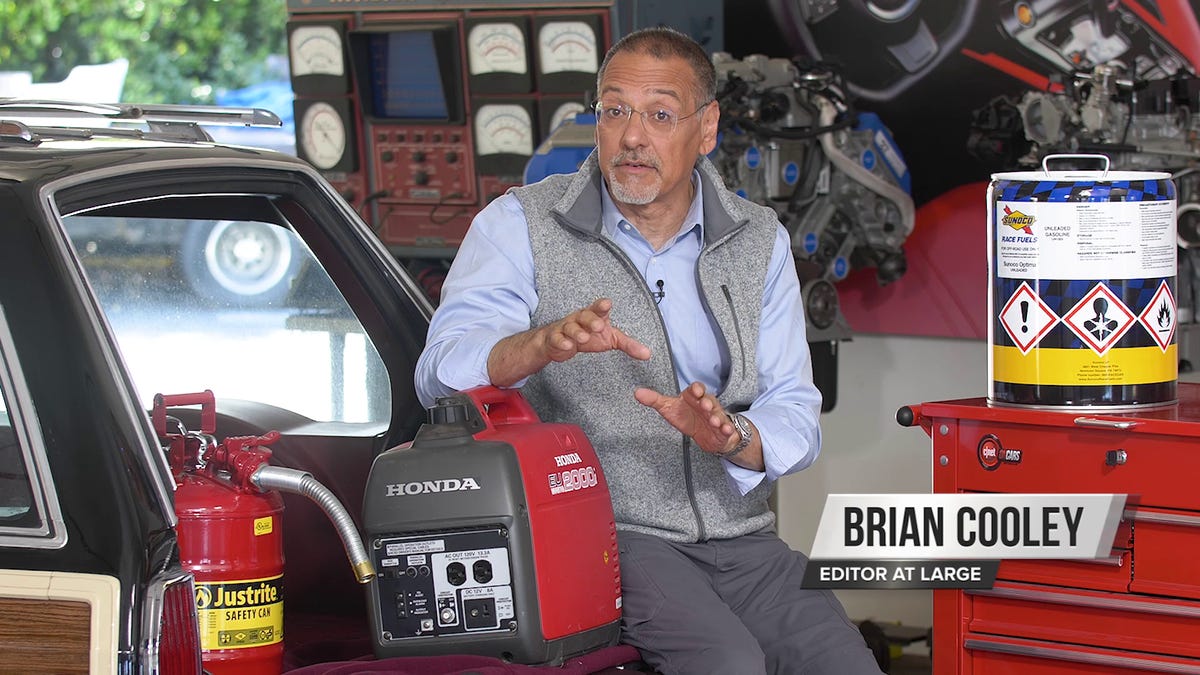 Why You Can Trust CNET
Why You Can Trust CNET Store plenty of fuel for your backup generator
Be ready for emergencies with fresh gas to keep your portable generator humming.

Learn the tips for keeping the best kind of backup generator ready to use.
More and more of us are keeping a gasoline-powered backup generator ready in case the power goes out due to flood, earthquake or fire. That gets you some solid peace of mind, but only if you focus as much on the fuel as the generator that will run on it.
The best generator
The best generator for survival use that doesn't require major installation or permitting is a portable unit delivering around 2,000 watts and based on a four-cycle engine. The most popular generator that fits this description seems to be the ubiquitous red Honda EU2000i (now superseded by the very similar Honda EU2200i) generator that quietly puts out 2,000 watts of clean, stable power suitable for anything from computers to table lamps. It can do that for up to 8 hours on a single fill of its 1-gallon tank.
The fact that these generators are powered by four-cycle engines is crucial as it means you run them on the same pump gas you put in your car. But it's not quite that simple, thanks to the introduction of time: While gas in your car is probably used in a week or two, generator fuel often sits for a year or more and can go bad in less than half that time. Oxidation, moisture and even microorganisms take their toll, leaving you with gas that will make your generator start hard and run poorly, if at all, when you need it.
Six easy steps
Know these techniques to have fuel ready to run your generator a year or more from now:
- Store gasoline with as little air in the container as possible. Gasoline oxidizes from exposure to air, causing it to break down. There will always be some air in any storage tank, but try to limit it.
- Store fuel tightly capped. Gasoline itself is hydrophobic, meaning it repels water, but the ethanol blended into gas these days is hygroscopic, meaning it will absorb water from the air. If too much water is absorbed, it bonds to the ethanol and separates it from the gasoline, creating a layer of liquid your generator will gag on.
Sunoco Optima is one formulation of gasoline that is happy to sit on a shelf for years. It's great for backup generators, but it may be very expensive where you live.
- Consider using gasoline without ethanol. You may have to seek it out from specialty marine or motorsports retailers, but a fuel like Sunoco Optima is ethanol-free and otherwise blended to be good on the shelf for at least three years. Consult your generator's manual and you'll probably find it can use ethanol in gas but doesn't need it.
Fuel stabilizers can extend the life of stored gasoline, but make sure you get one that is good at handling moisture.
- Look into fuel stabilizers. These are chemical additives you mix with gasoline to make it long-term stable. Look for one that includes the ability to manage water absorption over time. A study by University of Nebraska found that only two of eight brands of fuel conditioner on the market meaningfully increased the ability to contain water in ethanol-blended pump gasoline.
- Know your generator's octane and lead needs. This is easy, as most four-cycle generators map to Regular pump gas: modest octane and no lead. (Check out CNET's explanation of octane.)
- Know your municipality's rules on fuel storage. You may find that fire officials don't want you storing more than two 5-gallon containers of an approved design unless you have a proper fuel storage shed outdoors.
Be careful
Gasoline is serious, handle it properly:
- Keep a B-rated extinguisher nearby. The "B" means it can handle liquid fires.
- Do fueling outdoors or in a very well-ventilated garage.
Wipe up fuel spills when you pour gasoline -- the vapors creep low where ignition sources are often found -- and discard the rags outdoors or in an approved disposal can.
- Wipe up spills promptly and dispose of the rags outdoors, away from any source of ignition.
- Remember that gasoline vapor is heavier than air and creeps along the ground invisibly.
Siphoning your car
If all of this sounds like too much trouble, remember that you've probably got a supply of compatible gasoline in your car, ready for use in your generator. Getting it out and into a gas can or directly into your generator requires siphoning by mouth with a cut length of garden hose -- the old school way, not recommended -- or with a simple siphon kit kept for such emergencies.
The downsides of relying on gas from your car are fairly minor, but include the fact that too many of us run our cars close to empty -- using gas from your car reduces its availability for essential trips during an emergency when gas stations are closed. Also that siphoning is something of a lost skill, though a siphoning kit remedies that.

